Vaccine Negative Effectiveness
As outlined in the Vaccine Effectiveness section, the COVID vaccines were never tested for prevention of infection or transmission before being approved for market.
During the vaccine rollout, studies based on data from several weeks of observation after vaccination showed that the vaccine did prevent infection.
Now with longer-term studies, and with the changes in virus variants, it is becoming clear that the vaccines not only do not reduce infection but are highly correlated with increased infections just a few months after injection.
The following is a deeper look at scientific studies that document the same phenomenon.
Before examining how the vaccine's effectiveness drops over time, it's important to note that negative effectiveness has also been documented between the first and the second dose – a time period when the person is not even considered "vaccinated" despite having received the first injection.
This makes it look like the unvaccinated are getting infected more, but that's only because they are considered "unvaccinated" - despite having received their first injection. Many data sets fail to make this distinction between "injected" and "vaccinated", leading to inaccurate conclusions about the vaccine's effectiveness. Here are two examples of negative effectiveness between the first and second shots.
Pfizer's EUA application, June 2022
Pfizer's own FDA application for Emergency Use Authorization (EUA) for ages 6 months–4 years shows that between doses one and two, vaccine efficacy is -30% for babies, and -32% for toddlers.
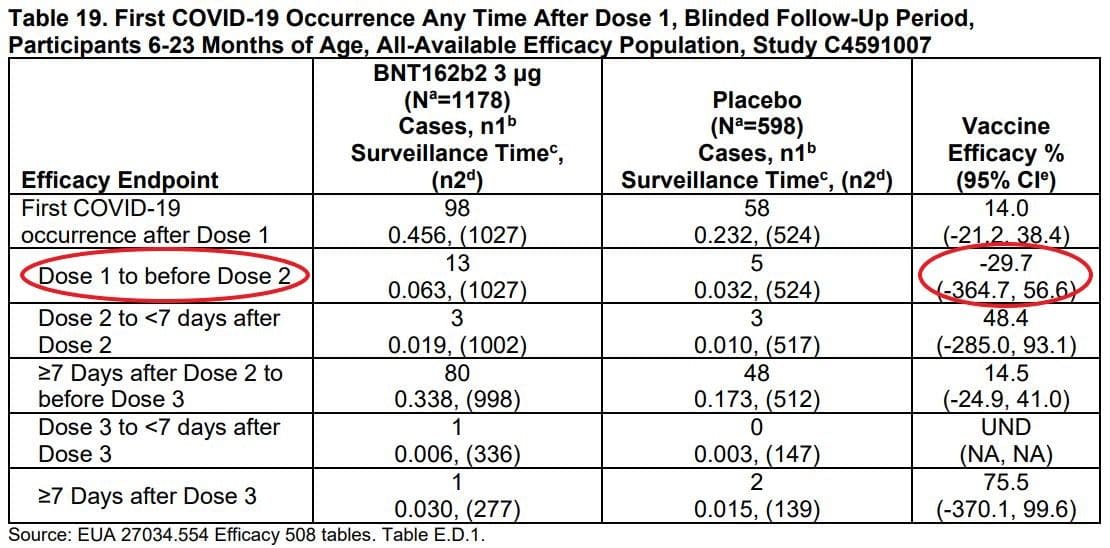
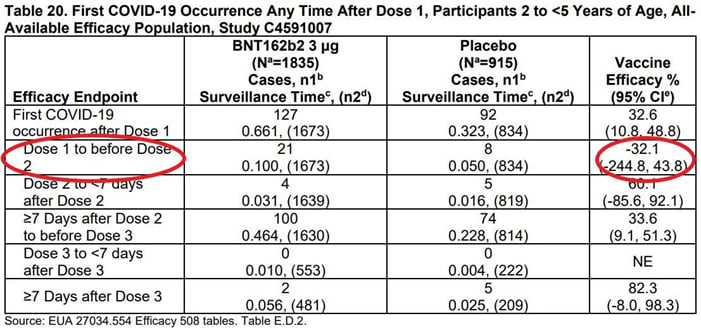
Source: https://www.fda.gov/media/159195/download (page 39)
Powell et al The Lancet, May 2022
This study of adolescents' vaccination when the Delta variant was circulating shows that children aged 12– 15 have overall negative vaccine effectiveness from the day of their first injection until the ninth day:
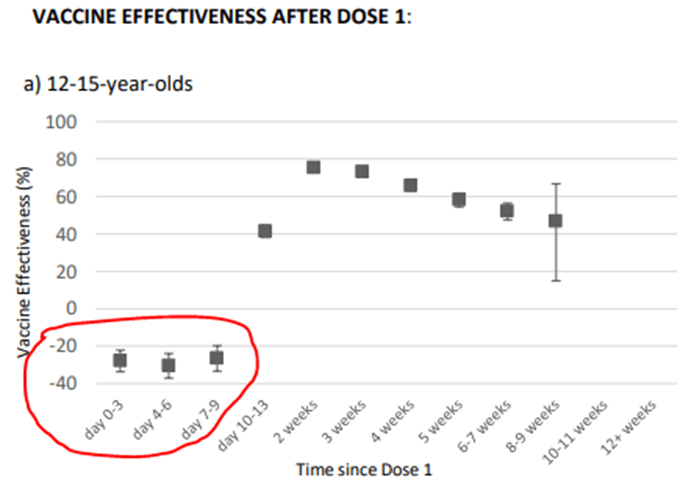
Source: https://www.medrxiv.org/content/10.1101/2021.12.10.21267408v1.full.pdf (page 6)
The following are a number of studies that show negative effectiveness emerging weeks after vaccination with most studies ending before effectiveness returns to zero.
Tseng et al., October 2022
In a paper on MedRxiv called “Effectiveness of mRNA-1273 against infection and COVID-19 hospitalization with SARS-CoV-2 Omicron subvariants: BA.1, BA.2, BA.2.12.1, BA.4, and BA.5,” Tseng et al. presented results from their study involving 123,236 adults comparing infection rates between the unvaccinated and the vaccinated after their third injection.
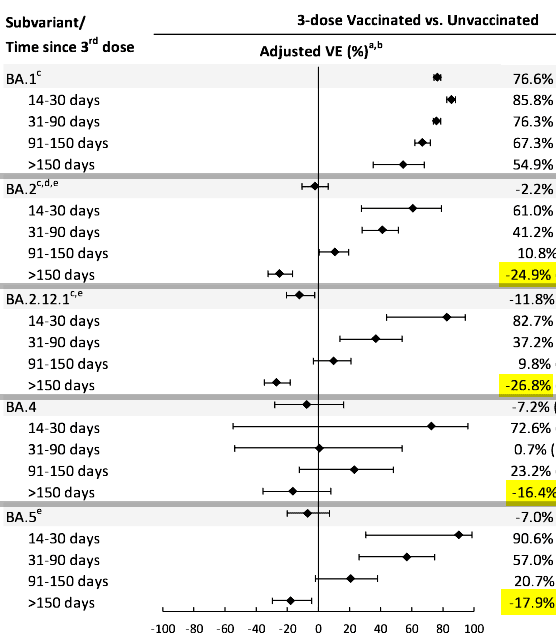
Apart from the original variant, vaccine effectiveness dropped into negative territory (-16% to -26%) after just 150 days from the third injection.
The following graph shows the declining effectiveness against BA5, the most prevalent variant at the time)
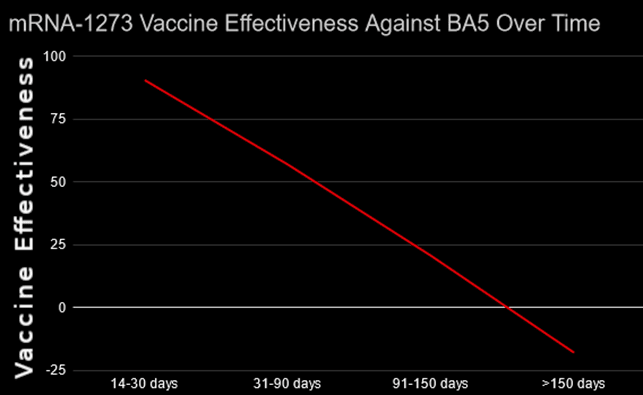
Rudan et al., September 2022
In a paper entitled “BNT162b2 COVID-19 vaccination uptake, safety, effectiveness and waning in children and young people aged 12–17 years in Scotland” in The Lancet Regional Health Europe, Rudan et al. examined the Pfizer-BioNTech shot’s effectiveness in children by studying Scottish children in the 12–17 years age bracket.
The Association of American Physicians and Surgeons tweeted a good synopsis:
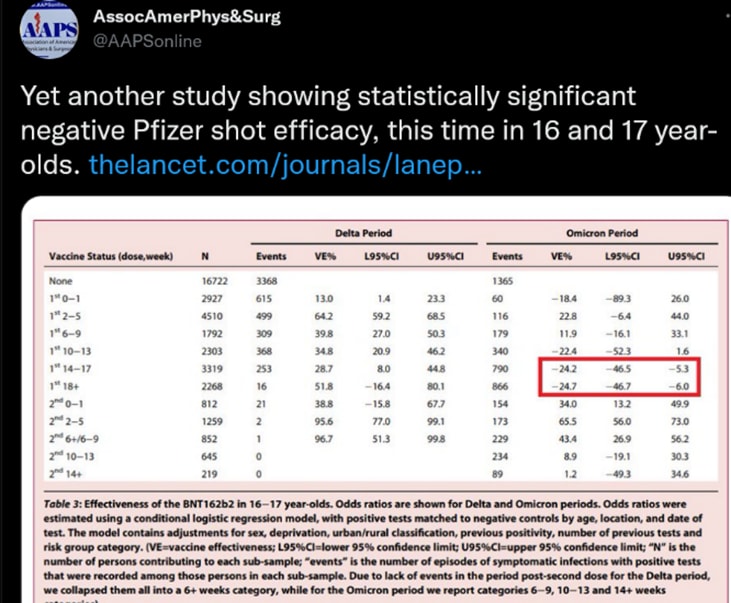
Original chart: https://www.thelancet.com/action/showFullTableHTML?isHtml=true&tableId=tbl0004&pii=S2666-7762%2822%2900209-5
Here, vaccine effectiveness went negative 10 weeks (70 days) after the first injection and remained around -22% or more for at least the following eight weeks (up to 126 days). Here, too, the study does not continue past 18+ weeks, so we don't know if or when it will rebound.
Here are the data for observed vaccine effectiveness after the 1st Pfizer shot:
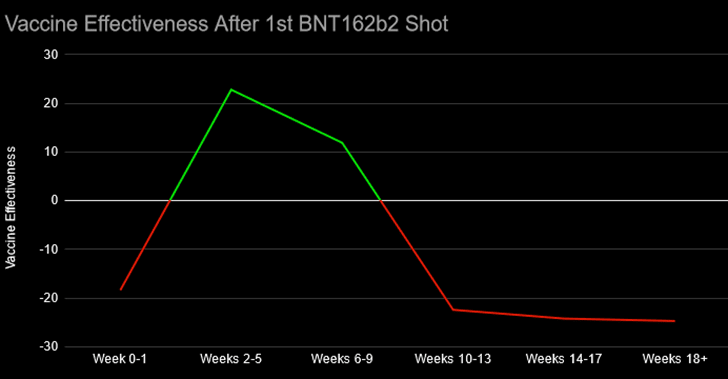
CDC Presentation, September 2022
According to data presented by the CDC at one of their meetings, in all age groups the booster efficacy falls quickly and in some age brackets smashes through into negative effectiveness territory.
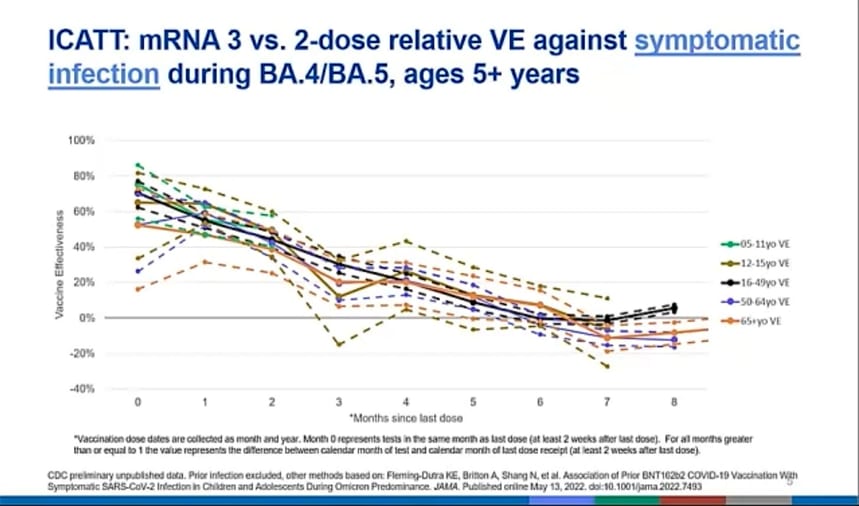
From Ruth Link-Gelles’s Presentation at CDC Sept 1st 2022 ACIP Meeting (Page 5)
Starting in week 6 (42 days) following the third dose, when compared to those who only had two doses, vaccine effectiveness drops below zero, and hovers around roughly -10% for most ages.
Xu, Li, Kirui et al Vaccines, September 2022
In their paper entitled “Effectiveness of COVID-19 Vaccines Over 13 Months Covering the Period of the Emergence of the Omicron Variant in the Swedish Population” published in The Lancet, Xu, Li, Kirui presented worrying findings.
VE [vaccine effectiveness] against COVID-19 infection after two doses of any vaccine peaked at week three with 72% but then dropped quickly to 19.5% by weeks 14–17 and showed no protection from week 18. From week 18 to week 52 VE was negative, ranging from 0 to -22%

This is even more evident in the ‘during Omicron' graph here:

Here we see negative VE starting at 15 weeks (105 days) dropping to nearly -100% at 52 weeks.
Hansen et al. December 2021
In a paper titled “Vaccine effectiveness against SARS-CoV-2 infection with the Omicron or Delta variants following a two-dose or booster BNT162b2 or mRNA-1273 vaccination series: A Danish cohort study,” Hansen et al. published data showing massively waning efficacy against Omicron in vaccinees with both brands of mRNA vaccine.
Description automatically generated">
By 91–150 days from the vaccination period, vaccine effectiveness fell solidly into negative territory: -76.5% for Pfizer, and -39.3% for Moderna.
The following graph shows the declining VE for both the Pfizer and the Moderna vaccines.
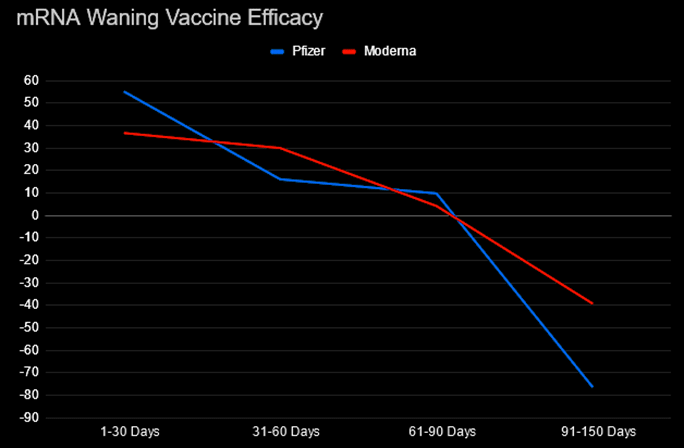
Nordström & Ballin The Lancet, February 2022
In their paper “Risk of infection, hospitalization, and death up to 9 months after a second dose of COVID-19 vaccine: a retrospective, total population cohort study in Sweden,” published in The Lancet, Nordström & Ballin were one of the firsts to document the drop to negative effectiveness.
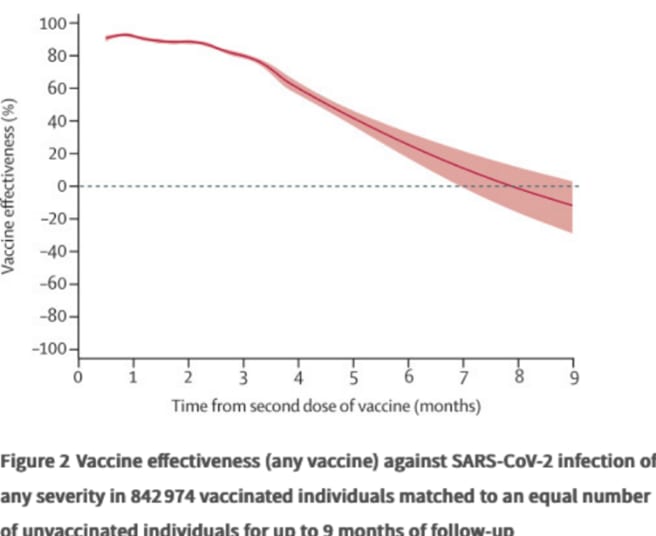
Here the effectiveness reaches zero 8 months (244 days) after the second dose and goes negative for the last month of the study period. The effectiveness is still dropping at the end without any clear sign of when it may level off.
Piernas et al The Lancet, August 2022
In their paper called “Associations of BMI with COVID-19 vaccine uptake, vaccine effectiveness, and risk of severe COVID-19 outcomes after vaccination in England: a population-based cohort study,” Piernas et al studied the vaccine effectiveness by the number of doses and duration since the last dose.
Here are the data for vaccine effectiveness for healthy-weight individuals.
The Odds Ratio (OR) indicates how much more likely it is for someone to test positive for COVID compared to an unvaccinated person.
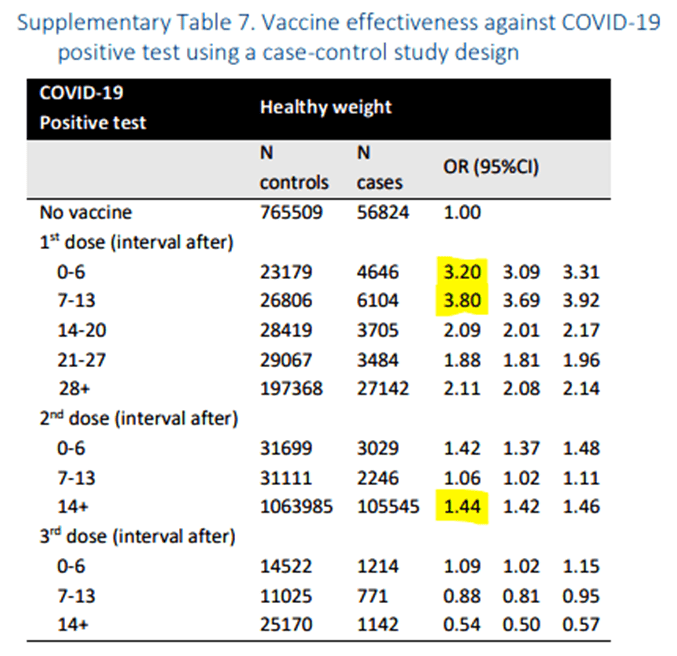
People who received one shot were 3.2 times more likely to test positive for COVID in the first week, 3.8 times more likely in the second week, 2.09 times more likely in the third week, 1.88 times more likely in the fourth week and 2.11 times more likely to test positive after that (through the end of the study).
Those who received two shots were 1.42 times more likely to test positive for COVID in the first week, 1.06 times more likely in the second week, and 1.44 times more likely to test positive after that (through the end of the study).
Fleming-Dutra et al JAMA, May 2022
In a paper published in JAMA (Journal of the American Medical Association) entitled “Association of Prior BNT162b2 COVID-19 Vaccination with Symptomatic SARS-CoV-2 Infection in Children and Adolescents During Omicron Predominance,” the data show negative effectiveness after about 6 months (183 days), going down to -20% after 7 months (213 days) with a sign of a rebound in the eighth month, but it still remains negative.
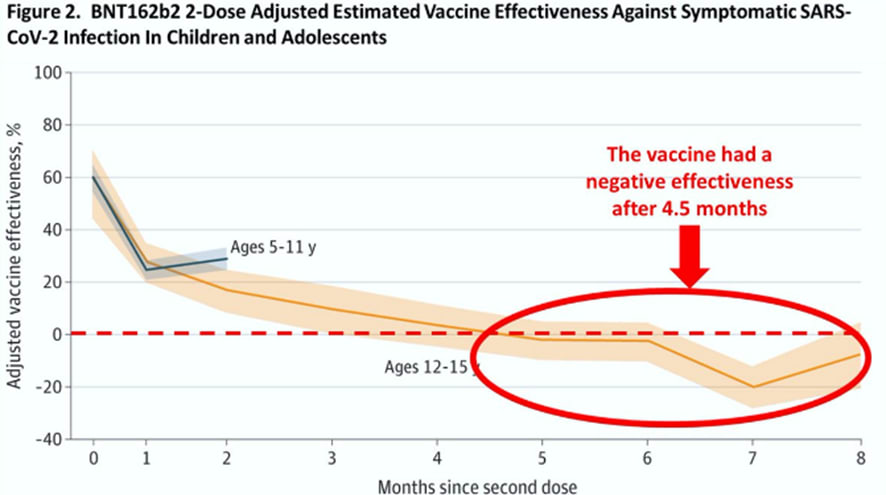
N. Shrestha et al., December 2022
This study looked at infection rates based on number of vaccine doses. The study stated that "the risk of COVID-19 also varied by the number of COVID-19 vaccine doses previously received. The higher the number of vaccines previously received, the higher the risk of contracting COVID-19."
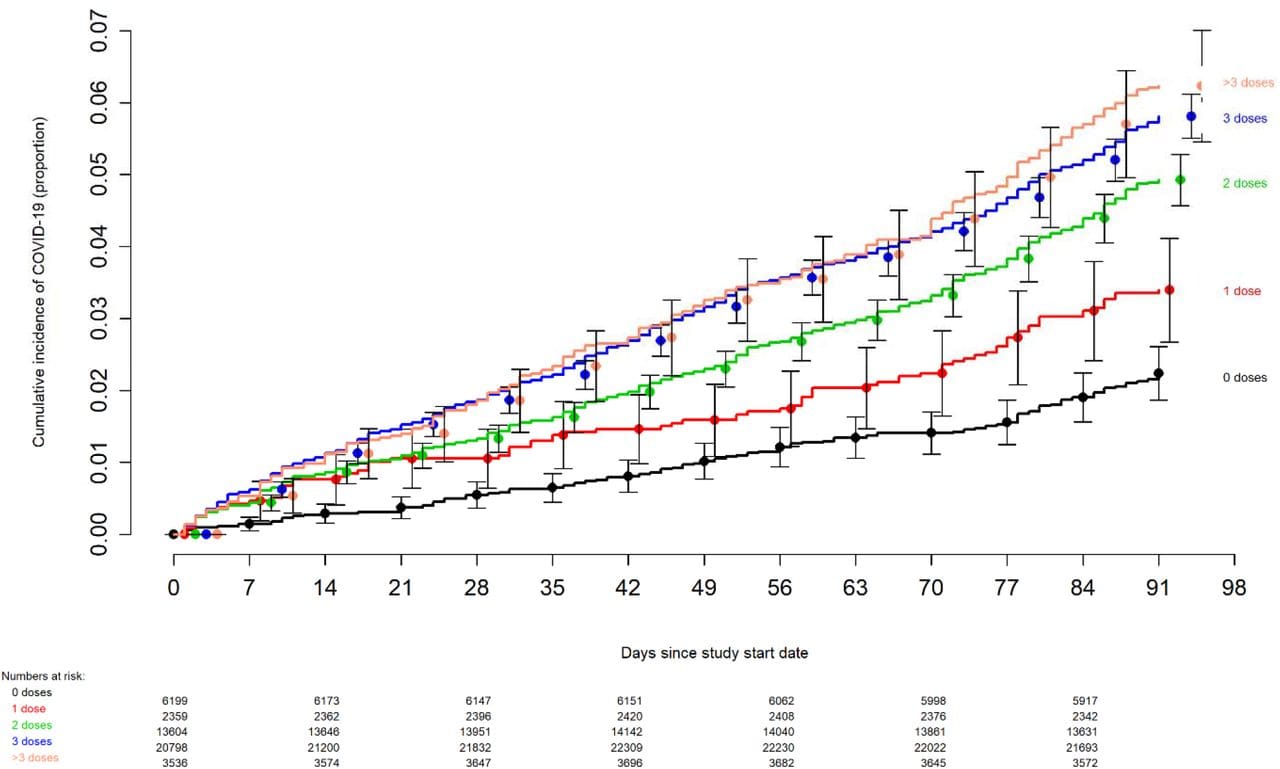
These eleven studies all show that COVID vaccines' effectiveness declined so much that they do not provide any protection against infection. Instead, they promote COVID-19 infections and by doing so also promote transmission to others. This is particularly disturbing since many of the vaccines were at very low risk of serious illness, yet they served as an amplified vector for transmitting the virus.
These studies suggest that the pandemic is being perpetuated by the very tool that was designed to stop it.
Email questions or comments to frontlinepedia@aflds.org
